For campers and caravan enthusiasts in the UK, a 12V solar charge controller is a vital component for efficiently and safely charging leisure batteries from solar panels. The choice often boils down to two main technologies: PWM (Pulse Width Modulation) and MPPT (Maximum Power Point Tracking).
- PWM controllers are simpler and more affordable. They essentially connect the solar panel to the battery, regulating the charging current by rapidly switching the connection on and off. They are less efficient, especially when the panel voltage is significantly higher than the battery voltage, but are perfectly adequate for smaller, less critical systems.
- MPPT controllers are more advanced and expensive. They actively track the maximum power point of the solar panel, converting excess panel voltage into additional current for the battery. This results in significantly higher efficiency (often 10-30% more power harvest, especially in varying light conditions or with higher voltage panels), making them ideal for larger systems or when maximizing every bit of solar energy is crucial.
Here’s a review of 10 12V solar charge controllers available on Amazon UK, with scores out of 10, and their pros and cons:
1. Victron Energy SmartSolar MPPT 75/15 Solar Charge Controller (Bluetooth) Price: £50-60
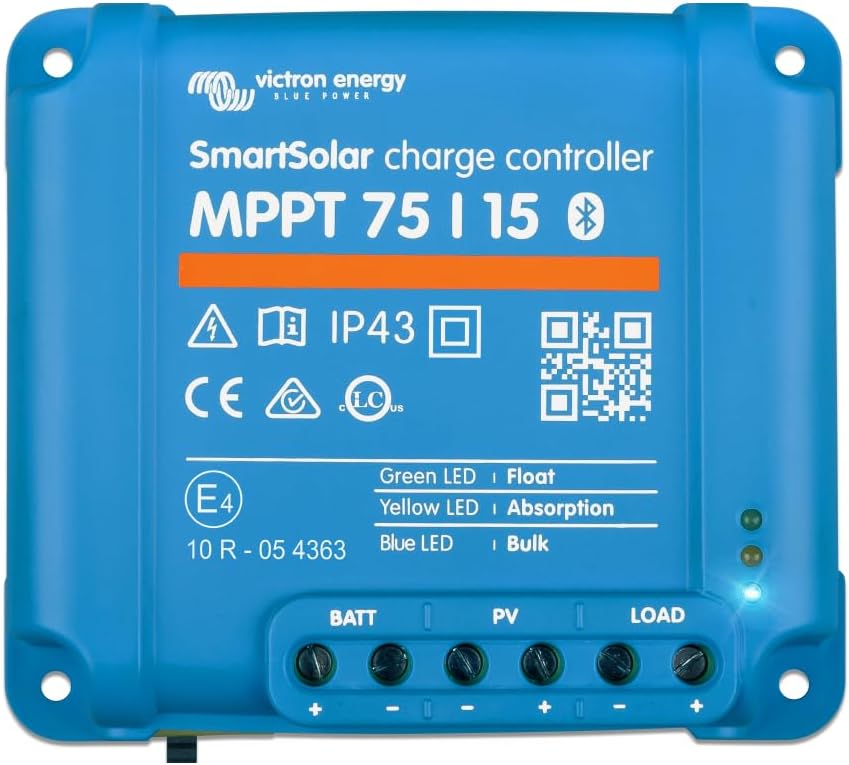
Score: 9.5/10
Victron Energy is a premium brand, and their SmartSolar range is highly regarded for its performance, reliability, and smart features. The 75/15 is a popular choice for many campervan and caravan setups.
Pros:
- MPPT Technology: Superior efficiency, especially in varying light conditions, extracting more power from your solar panels compared to PWM.
- Bluetooth Connectivity: Allows for comprehensive monitoring and configuration via the VictronConnect app on your smartphone, including real-time data, historical data, and custom battery charge settings.
- High Build Quality: Known for being robust and reliable, offering excellent longevity.
- Adaptive BatteryLife Algorithm: Intelligently manages load disconnect to prevent battery over-discharge and prolong battery life.
- Versatile Battery Support: Compatible with various battery types, including Lead-Acid (Flooded, AGM, Gel) and Lithium (LiFePO4).
- Load Output: Can manage a DC load directly, with programmable low-voltage disconnect to protect the battery.
Cons:
- Price: It’s one of the more expensive options on the market.
- No Integrated Display: Relies on the Bluetooth app for monitoring, which might not suit everyone (though a remote display is available separately).
- Over-sizing Needed: Max 15A output, so you’ll need to consider panel wattage carefully (e.g., typically suitable for up to 200W of 12V panels, or more if using higher voltage panels).
2. Renogy Rover Li 20A MPPT Solar Charge Controller Price: £250 – £300
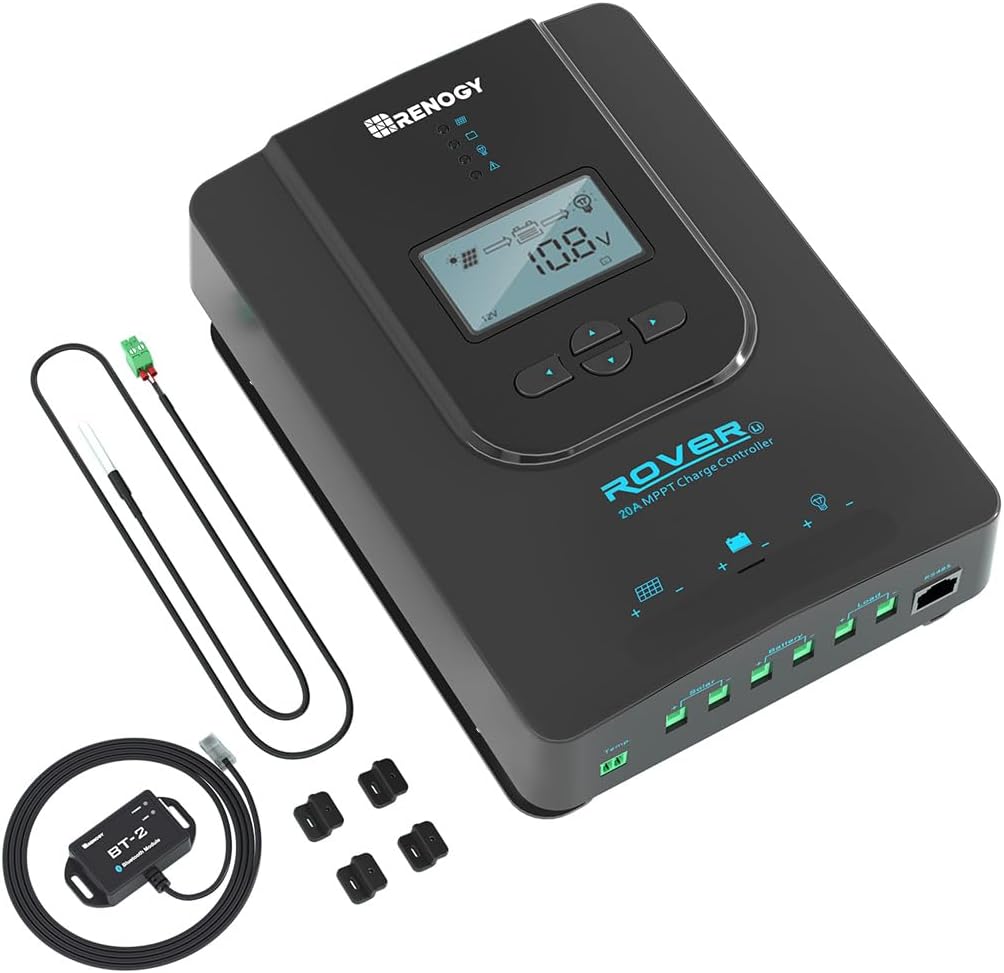
Score: 8.5/10
Renogy is another well-respected brand in the solar industry, offering a strong balance of performance and features with their Rover Li series.
Pros:
- MPPT Technology: Excellent efficiency for maximizing solar harvest.
- LCD Display: Built-in screen provides direct access to real-time charging data, battery voltage, and settings.
- Programmable Battery Types: Supports various battery chemistries, including Lithium (LiFePO4), Gel, Sealed, and Flooded.
- Comprehensive Protections: Offers multiple electronic protections against overcharge, over-discharge, overload, short-circuit, and reverse polarity.
- Optional Bluetooth Module: While not integrated as standard, an optional Bluetooth module allows for app-based monitoring.
- Durable Design: Solid construction for reliable use.
Cons:
- Bluetooth is Separate: Requires an additional purchase for wireless monitoring.
- Fan Noise: Some users report that the cooling fan can be audible under heavy load.
- Slightly Bulkier: May take up more space compared to smaller, display-less MPPT controllers.
3. EPEVER MPPT 20A Solar Charge Controller. Price £70 – £80
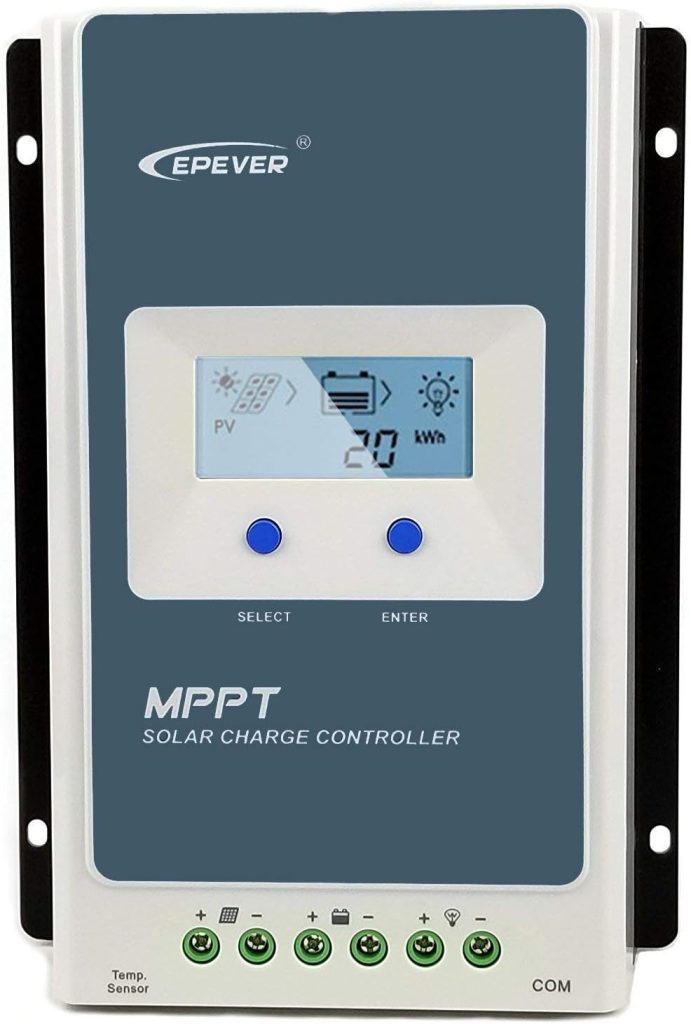
Score: 8/10
EPEVER (formerly EPSolar) is known for offering good value MPPT controllers with robust features.
Pros:
- True MPPT Tracking: High tracking efficiency (often >99.5%) and conversion efficiency (up to 98%).
- Auto System Voltage Recognition: Automatically detects 12V or 24V battery systems.
- Common Negative Design: Safer for RV/caravan applications where the negative terminal is often common.
- Multiple Battery Types: Supports Lead-Acid (Sealed, Gel, Flooded) and Lithium batteries with customizable parameters.
- Optional Accessories: Can be extended with a remote meter (MT50), temperature sensor, and Bluetooth module for enhanced monitoring and control.
Cons:
- Basic Integrated Display: The unit itself might have a less intuitive display compared to some competitors; a remote meter is often recommended for better usability.
- Bluetooth/Remote Meter Separate: Like Renogy, these are optional extras.
- User Manual: Some users find the manual can be a bit technical or less clear in certain areas.
4. ECO-WORTHY 30A Solar Charge Controller. £30 – £35
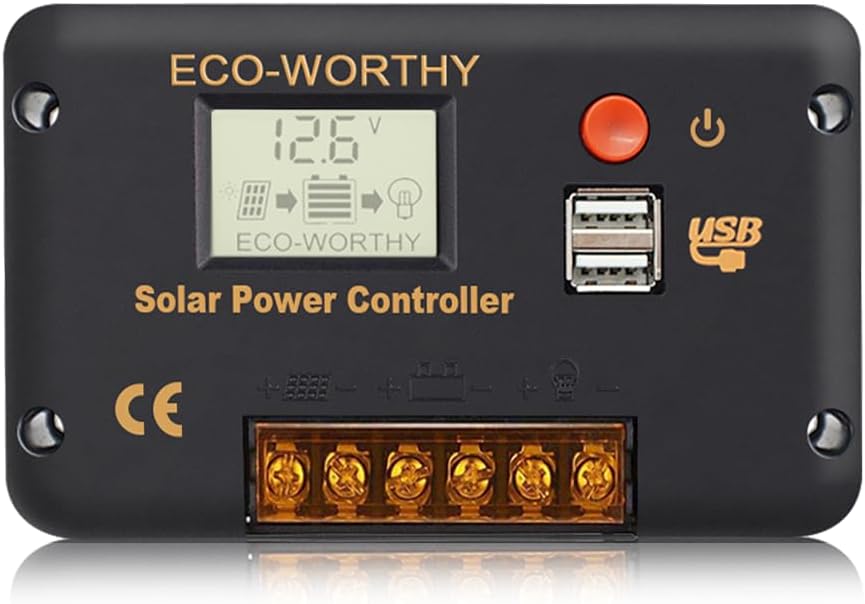
Score: 7.5/10
ECO-WORTHY offers a more budget-friendly MPPT option, often bundled with solar panels.
Pros:
- MPPT Technology: Provides the benefits of MPPT efficiency at a more accessible price point.
- LCD Display: Built-in display for monitoring system status.
- Dual USB Ports: Convenient for direct charging of mobile devices.
- Battery Type Settings: Supports various battery chemistries.
- Multiple Protections: Includes standard safety features.
Cons:
- Brand Reputation: While generally positive, may not have the same long-standing reputation for robust reliability as Victron or Renogy.
- Software/Firmware: User interface or advanced settings might be less refined than premium brands.
- Customer Support: Experiences can vary.
5. HQST A40 MPPT Solar Charge Controller (with Bluetooth & LCD Display) £300 – £350
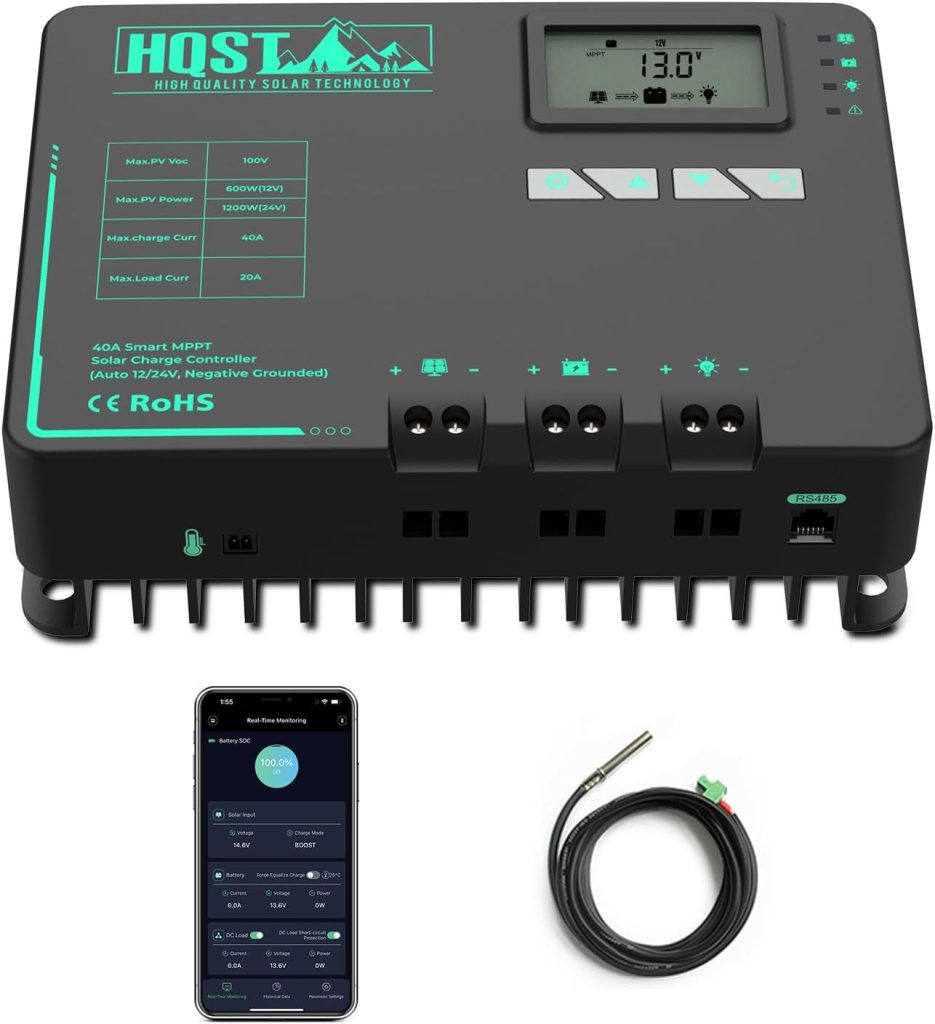
Score: 7.5/10
HQST is another brand that aims to offer MPPT technology with useful features at a competitive price point.
Pros:
- MPPT Efficiency: Maximizes power harvesting from solar panels.
- Integrated Bluetooth: Allows for wireless monitoring and configuration via a smartphone app.
- LCD Display: Provides direct visual feedback on system status.
- Negative Grounded: Suitable for many RV and marine installations where a common negative ground is used.
- Supports Lithium Batteries: Compatible with various battery types, including LiFePO4.
Cons:
- App Quality: The accompanying app might not be as polished or feature-rich as Victron’s.
- Long-Term Reliability: As with some newer or less established brands, long-term reliability can be a consideration.
- Fan Noise: May have an audible fan, though often smart-controlled.
6. Photonic Universe 10A PWM Solar Charge Controller. £15 – £20
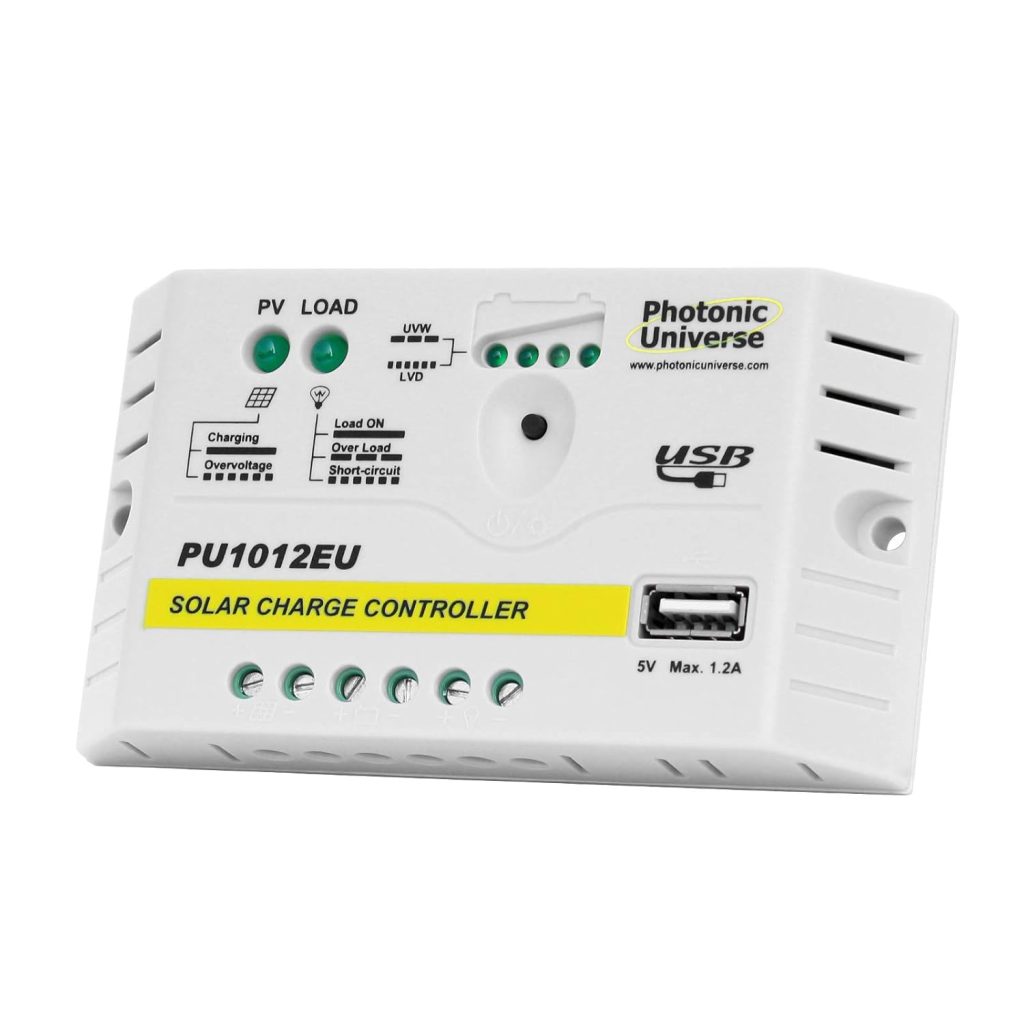
Score: 6.5/10
Photonic Universe is a popular UK-based supplier of solar equipment, offering reliable PWM controllers for smaller systems.
Pros:
- Simple and Reliable: A straightforward, robust PWM controller suitable for basic charging needs.
- Affordable: A good budget option for smaller solar setups (e.g., 100W panel or less).
- Essential Protections: Includes reverse current, overcharge, discharge, overload, and reverse polarity protection.
- Often Part of Kits: Frequently sold as part of comprehensive solar kits, making it convenient.
- Good for Flooded/AGM Batteries: Works well for traditional lead-acid batteries.
Cons:
- PWM Efficiency: Less efficient than MPPT, especially if your panel voltage is much higher than your battery voltage (e.g., typical 20V+ solar panel charging a 12V battery).
- No LCD Display: Often a basic unit without a screen, requiring external monitoring if desired.
- Limited Features: Lacks advanced programming or monitoring options.
- Lower Current Rating: 10A limits the size of the solar array it can handle (e.g., maximum around 170W for 12V).
7. ALLPOWERS 20A PWM Solar Charge Controller. £10 – £15
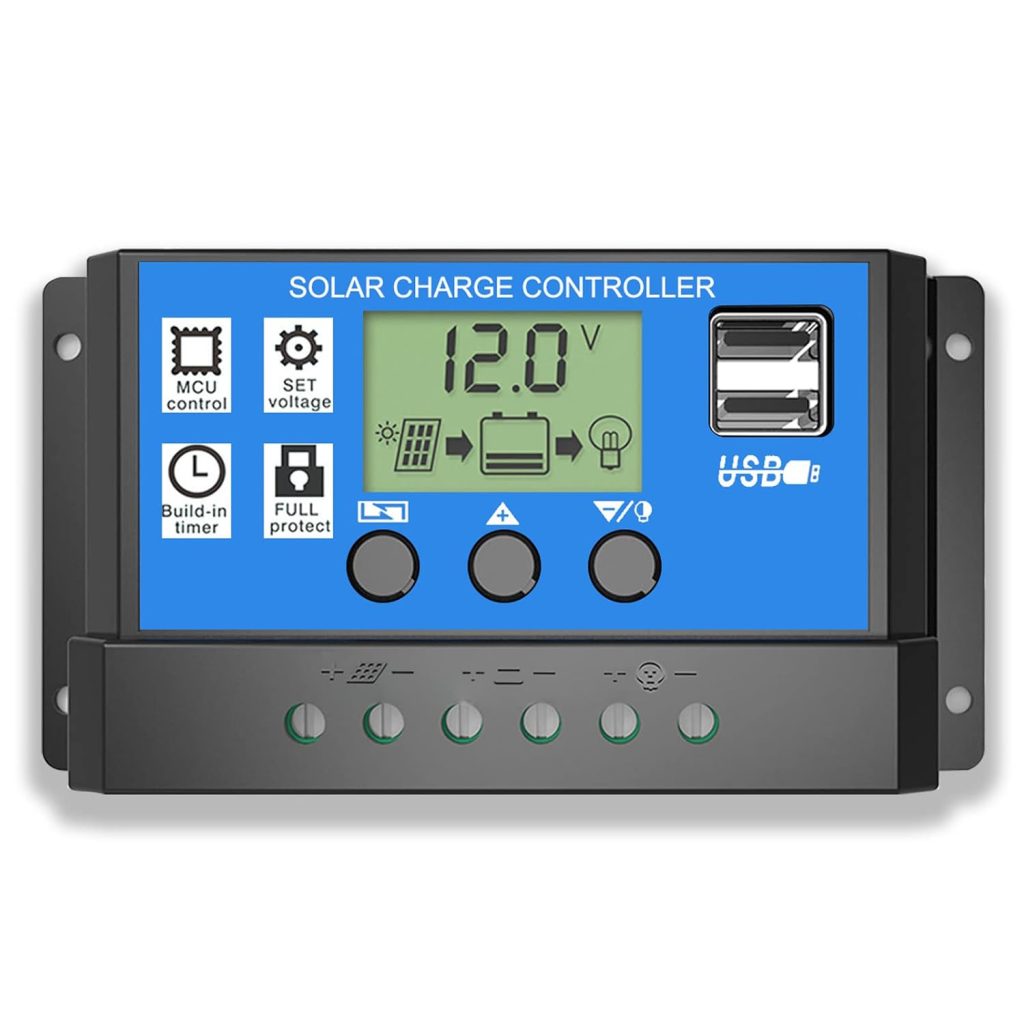
Score: 6/10
ALLPOWERS offers a very affordable PWM controller with a built-in display and USB ports, making it popular for entry-level setups.
Pros:
- Very Affordable: One of the cheapest options available.
- LCD Display: Provides basic information on battery voltage, charging status, and load settings.
- Dual USB Ports: Handy for charging phones and tablets directly from the controller.
- Auto 12V/24V Recognition: Can work with both 12V and 24V systems.
- Timer Setting for Load: Allows for basic control of a connected DC load (e.g., for lights).
Cons:
- PWM Limitations: Less efficient than MPPT, especially in less-than-ideal conditions.
- Build Quality: May feel less robust than higher-priced alternatives; reliability can be inconsistent.
- Basic Manual: Instructions might be unclear for beginners.
- Connect Battery First Rule: Crucial to connect the battery before the solar panel to avoid damaging the unit.
8. DOKIO 160W 18V Solar Panel Kit. £130 – £140
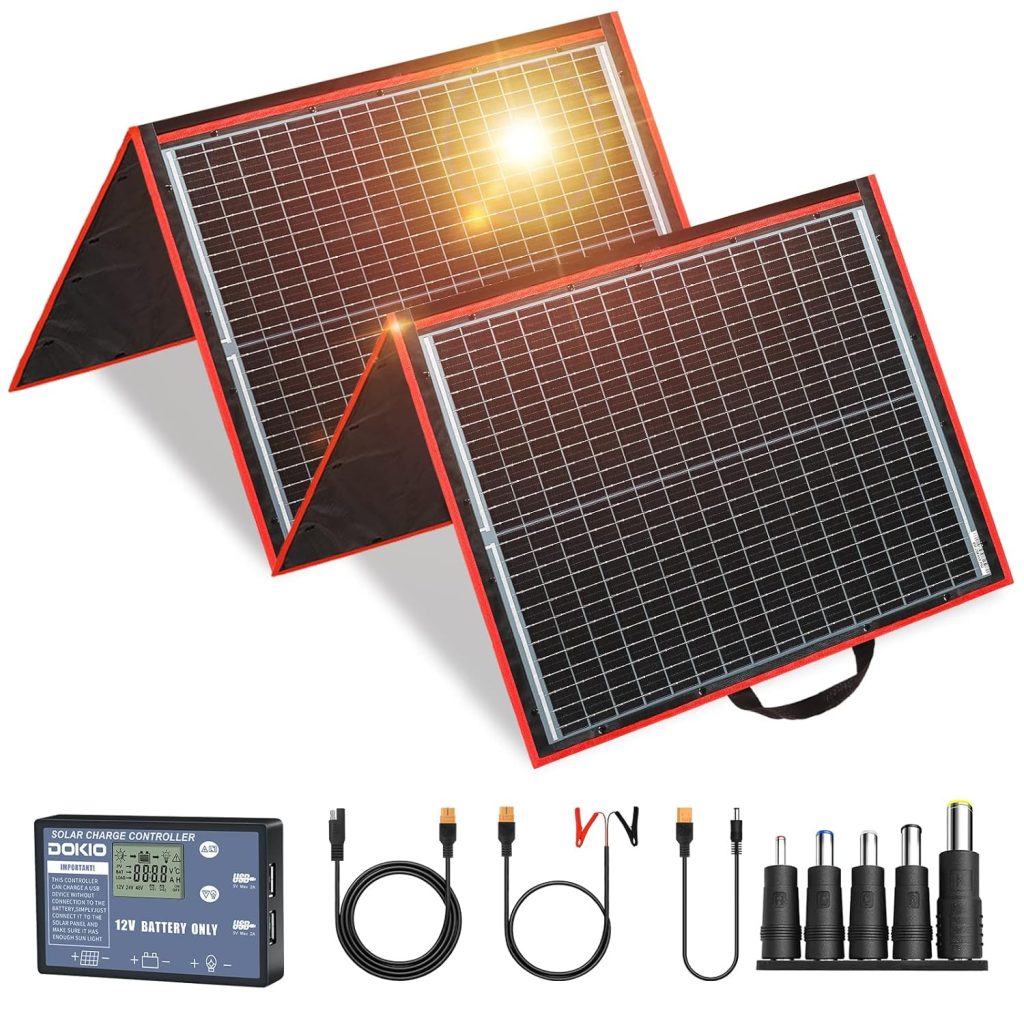
Score: 5.5/10
Often seen as part of Dokio’s popular foldable solar panel kits, this is a basic PWM controller designed for simplicity.
Pros:
- Integrated with Kits: Convenient if you’re buying a complete portable solar panel kit.
- LCD Display: Provides basic readings for voltage and status.
- Simple Operation: Generally plug-and-play for straightforward use.
- USB Ports: For direct charging of devices.
Cons:
- PWM Technology: Standard efficiency limitations.
- Basic Features: Lacks advanced battery management or monitoring capabilities.
- Durability Concerns: Some reports suggest the longevity of these budget controllers might be shorter than more established brands.
- No Load Output: Some versions may not have a dedicated load terminal, meaning you can only charge batteries, not power devices directly through the controller.
9. Y&H MPPT 30A Solar Charge Controller (Higher Amperage Budget MPPT) £15 -£20
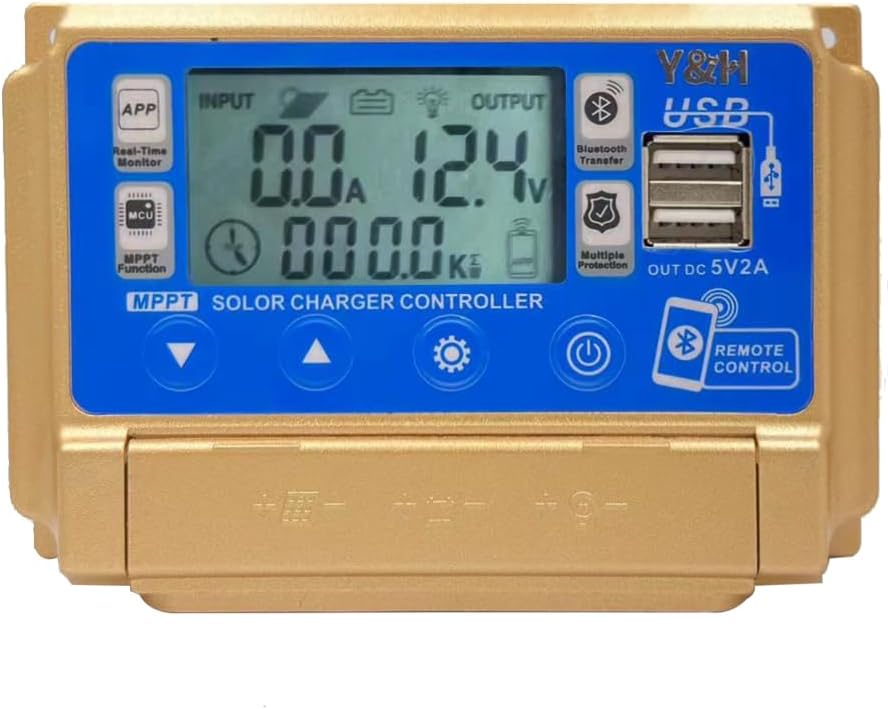
Score: 7/10
Y&H often offers higher-amperage MPPT controllers at very competitive prices, aiming for value.
Pros:
- MPPT Technology: Offers efficiency gains over PWM.
- Higher Amperage: 30A capacity allows for larger solar arrays (up to approx. 400W for 12V systems).
- LCD Display: For real-time monitoring.
- Dual USB Ports: Adds convenience for device charging.
- Supports Various Batteries: Including Lithium.
Cons:
- Brand Reliability: While offering good features for the price, the long-term reliability and build quality can be a concern for some users compared to premium brands.
- App/Software Quality: If it has a companion app, it might be less refined.
- Documentation: User manuals can sometimes be vague or poorly translated.
10. PowMr 30A MPPT Solar Charge Controller. £50 – £60
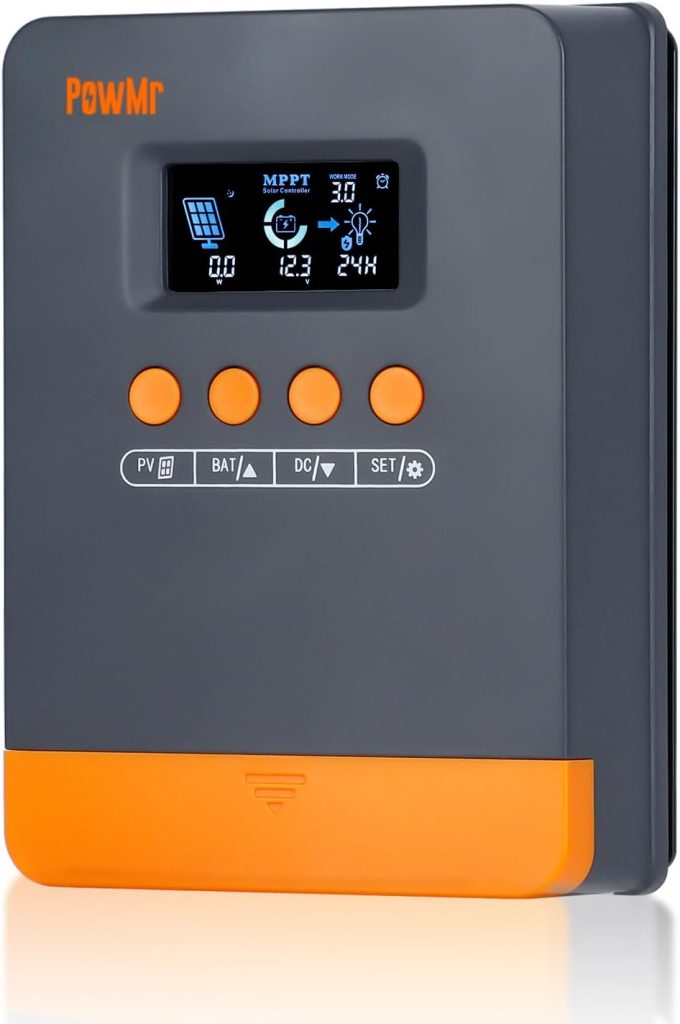
Score: 7/10
PowMr is another brand competing in the budget-friendly MPPT space, offering higher amperage options.
Pros:
- MPPT Technology: Aims to maximize solar yield.
- Higher Current Capacity: 30A allows for larger solar panel setups.
- LCD Display: For monitoring system parameters.
- Battery Type Support: Compatible with various battery chemistries, including Lithium.
- Good Value: Offers MPPT features at a competitive price.
Cons:
- Display Readability: Some users report that the LCD display can be dim or difficult to read in certain lighting conditions.
- Fan Noise: Like many higher-amperage units, fan noise can be present under load.
- Customer Support/Documentation: Can be hit or miss compared to top-tier brands.
- Potential for Inconsistent Performance: Some reviews indicate occasional quirks or less stable performance than more expensive units.
Key Advice for Choosing a Solar Charge Controller:
- Determine Your Needs: Calculate your maximum solar panel wattage. If it’s over 100-150W, an MPPT controller is usually worth the extra cost for the efficiency gains. For smaller, simpler setups, a PWM might suffice.
- Battery Type: Ensure the controller is compatible with your battery chemistry (Lead-Acid, AGM, Gel, LiFePO4). MPPT controllers generally offer more precise charging profiles for different battery types.
- Future Expansion: If you plan to add more solar panels later, choose a controller with a higher amperage rating than your current needs.
- Monitoring: Decide if you prefer an integrated LCD screen, a remote display, or smartphone app integration for monitoring your system.
- Budget: MPPT controllers are more expensive but offer better long-term performance and efficiency. PWM controllers are budget-friendly but less efficient.
